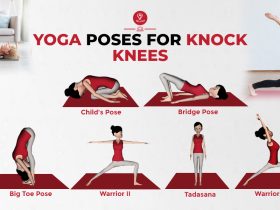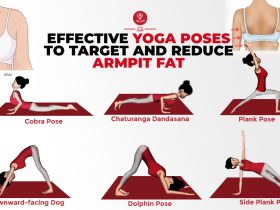
Yoga side bends, also known as lateral bends, are a group of yoga poses that involve bending the spine sideways, creating a gentle or deep stretch along the sides of the body. These poses typically involve elongating one side of the torso while actively contracting and engaging the muscles on the opposite side.
Benefits of Side Bending in Yoga
Yoga side bends are practiced for various reasons, including physical, energetic, and mental benefits.
Here are some key benefits and reasons why incorporating side bends into your yoga practice can be beneficial:
Side bends are an excellent exercise to release tension, improve flexibility, enhance breathing capacity, build strength, increase mobility, and promote a healthier range of motion in the spine. They build stamina and endurance, improve concentration and lead to a feeling of lightness, freedom, and emotional release. Regular practice of these yoga postures will also provide the following benefits:
- Stretch and strengthen the muscles along the sides of the spine.
- Improved posture.
- Side bends stimulate and balance the energy channels (nadis) in the body.
- Open the intercostal muscles and the muscles surrounding the ribs.
- Strengthen the muscles of your core.
- Opening the side body.
- Improves circulation
- Increased lung capacity
- Energetic balance.
- Open the heart
Yoga Side Bends Poses
Yoga side bends can be performed in various positions, including standing, seated, or lying down. They often involve reaching the arms overhead or to the side while maintaining a lengthened spine. Some common yoga side bend poses include:
Mountain Side Stretch Pose ( Triyaka Tadasana)
Inhale and raise your arms overhead, interlocking your fingers and pressing your palms toward the ceiling. Exhale and lean gently to one side, lengthening the opposite side of your body. Hold for a few breaths, feeling the stretch along the side body. Inhale to come back to the center and repeat on the other side.
Triangle Pose (Trikonasana)
Step your feet wide apart, about 3 to 4 feet. Turn your right foot out 90 degrees and pivot your left foot slightly inward. Extend your arms out to the sides parallel to the floor. Inhale and reach forward with your right hand, hinging at the hip, and then place your right hand on your shin, ankle, or a block. Extend your left arm up towards the sky, creating a straight line from your left heel to your fingertips. Hold the Triangle pose for several breaths, feeling the stretch along the side body. Inhale to come back up and repeat on the other side.
Half Moon Pose (Ardha Chandrasana)
This standing balancing pose involves balancing on one leg while extending the other leg straight out to the side. The hand of the lower arm rests on the ground or a block, while the upper arm extends towards the sky, creating a lateral stretch.
Gate Pose (Parighasana)
Come to a kneeling position with your knees hip-width apart. Extend your right leg out to the side, keeping your foot grounded. Inhale and raise your left arm up overhead. Exhale and lean to the right, bringing your right hand down towards your right leg, or a block. Feel the stretch along the left side of your body. Hold for a few breaths and then return to the center. Switch sides and repeat Parighasana.
Extended Side Angle (Utthita Parsvakonasana)
This standing pose involves extending one leg to the side, bending the front knee, and placing the hand of the front arm on the ground or a block. The other arm reaches overhead, creating a diagonal side stretch.
Head to Knee Pose (Janusirsasana)
Head-to-Knee Forward Bend is a seated yoga pose that provides a deep stretch to the back of the legs, hips, and spine. Start by sitting on the floor with your legs extended straight in front of you. Bend your right knee and bring the sole of your right foot against the inner left thigh. Keep your right knee grounded on the floor. lengthening your spine and slowly fold forward from the hips, reaching toward your left foot with both hands. Extend your chest towards your left leg. Stay in the pose for 30 seconds to a minute, breathing deeply and maintaining a gentle stretch.
Side Plank Pose (Vasisthasana)
Vasisthasana is an intermediate to advanced yoga pose that strengthens the arms, core, and legs while improving balance and stability. Start by coming into a plank position. Shift your weight onto your right hand and roll onto the outer edge of your right foot, stacking your left foot on top of the right. Extend your left arm toward the ceiling, aligning it with your shoulder. Press through the inner edges of your feet and the outer edge of your right hand to lift your hips. Make a straight line from your head to your heels. Hold the pose for 30 seconds to a minute.
These are just a few examples of yoga side bends, and there are many variations and modifications available to accommodate different levels of flexibility and body types.
Conclusion
Yoga side bends poses are a group of yoga asanas that involve bending the spine sideways, creating a stretch along the sides of the body. And can be practiced in various positions, including standing, seated, or lying down.
Incorporate side bends into your daily yoga routine to feel stretch the muscles on your sides and open the rib cage and expand the chest. They build stamina and endurance, build strength, increase mobility, and enhance immunity and energy levels.
RELATED ARTICLES
May 20, 2025
Kegel Exercises: Strengthen Your Pelvic Floor for Better Health
Kegel exercises strengthen the pelvic floor muscles, which support the uterus, bladder, small intestine and rectum. Strengthening these muscles improves[...]
Oct 06, 2024
Balance Your Body: Yoga Poses For Knock Knees (Genu Valgum)
Knock knees, or “genu valgum,” is a condition in which the knees touch each other while the ankles remain apart.[...]
Sep 20, 2024
Effective Yoga Poses to Target and Reduce Armpit Fat
Fat accumulation under the arms is a common problem for many women, which is often considered an important part of[...]
RECENT POSTS
Disclaimer
The content is purely informative and educational in nature and should not be construed as medical advice. Please use the content only in consultation with an appropriate certified medical or healthcare professional






